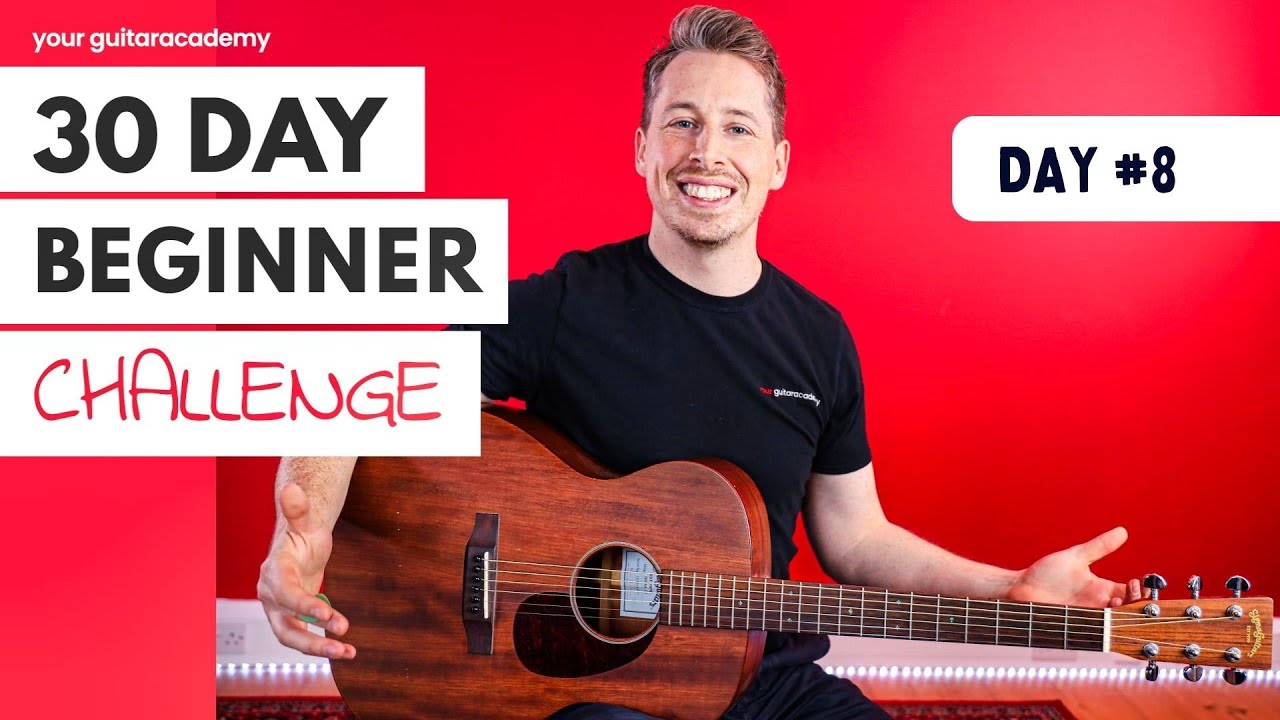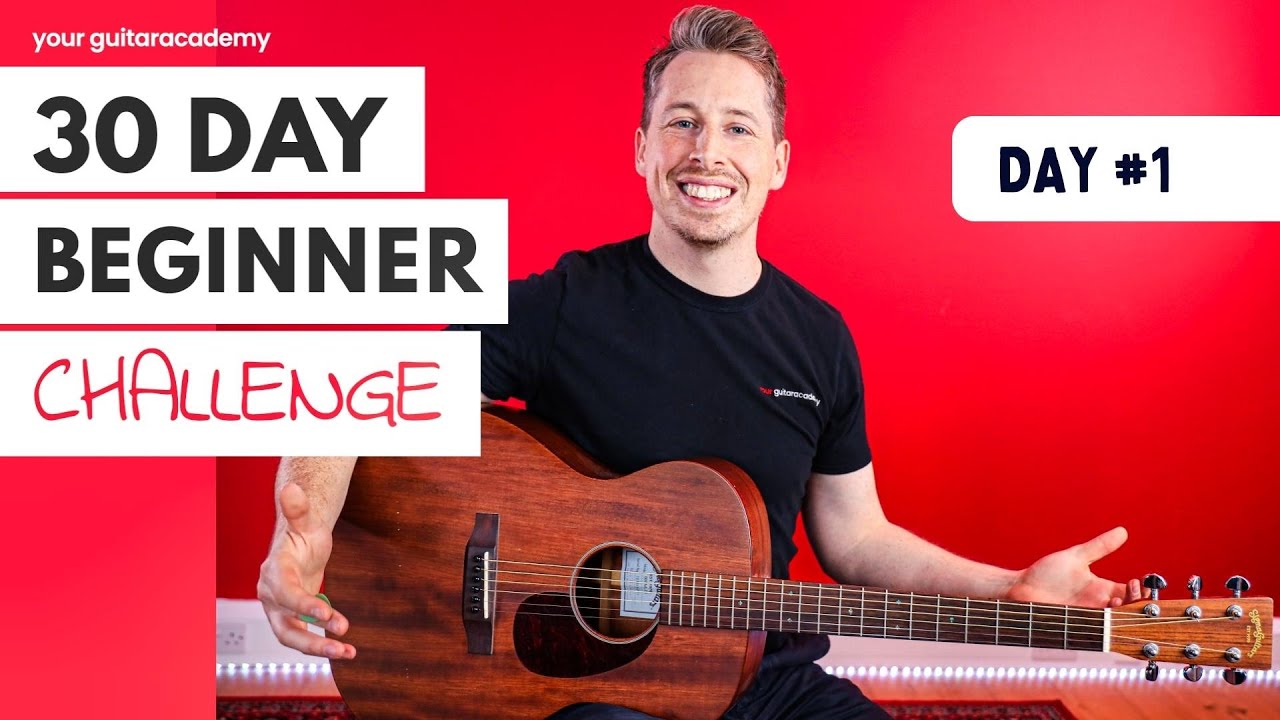30 Day Beginner Challenge [Day 7] Guitar Lessons For Beginners
Summary
TLDRIn this guitar lesson from the 30-day beginner challenge, instructor Dan revisits the exercise from the previous day, emphasizing the importance of practicing. He introduces the concept of guitar tablature (tab) as the written language of the guitar, demonstrating how to read and write the first bar of the exercise in both fourth and eighth notes. Dan explains the basics of tab, including its function as a timeline and a guide for finger placement and timing. Viewers are encouraged to visit the website for full lesson materials, and to practice the exercise using the provided tab as a reference.
Takeaways
- 🎸 Lesson Seven of the 30-day beginner challenge focuses on reviewing the exercise from the previous day and introducing the concept of tab, the written language of the guitar.
- 🔄 The exercise can be played in either fourth notes or eighth notes, with the eighth note version being faster and suitable for more advanced beginners.
- 📝 Tab is a simplified form of musical notation that shows the strings and frets to play on the guitar, making it easier for guitarists to understand where to place their fingers.
- 📑 Tabs are laid out with six lines representing the six strings of the guitar, with numbers indicating the frets to be played.
- 🎼 Tabs also function as a timeline, indicating the rhythm and timing of the notes to be played, which is crucial for playing along with a beat.
- 👉 The instructor demonstrates how to write out the first two bars of the exercise in tab, showing the progression from the E string to the A string.
- 📈 The importance of practicing the exercise both in fourth and eighth notes is emphasized, with the choice depending on the learner's skill level and comfort.
- 📚 The website is mentioned as a resource for full write-ups of lessons, including tabs, chord boxes, and fretboards, to aid in mastering the material.
- 👍 The instructor encourages viewers to like, subscribe, and comment on the YouTube channel for support and to ask questions.
- 🎓 The lesson concludes with homework to practice the exercise and review the full tab on the website, reinforcing the importance of practice for learning.
- 🔗 Links to the next lesson and the beginning of the playlist are provided for easy navigation and continued learning.
Q & A
What is the main focus of the lesson in the provided script?
-The main focus of the lesson is to review the exercise learned in the previous day and to introduce and explain the concept of guitar tablature (tab), showing how to read and write it for the exercise.
What is the purpose of the 30-day beginner challenge mentioned in the script?
-The 30-day beginner challenge is a structured learning program designed to help beginners learn to play the guitar in a step-by-step manner over a period of 30 days.
How does the instructor suggest practicing the exercise from the previous lesson?
-The instructor suggests practicing the exercise by going over it one more time and learning to read and write it in tab to understand the timing and finger placement.
What is the significance of the term 'steps' mentioned in the script?
-The term 'steps' refers to a specific guitar exercise that involves playing the frets 5, 6, 7, and 8 in sequence, which is a common practice pattern for beginners.
How does the instructor describe the difference between playing the exercise in fourth notes and eighth notes?
-The instructor explains that playing the exercise in eighth notes effectively doubles the speed of the exercise compared to playing it in fourth notes, as you have to play eight notes in the space of four.
What is the basic structure of a tab according to the script?
-The basic structure of a tab consists of six lines representing the six strings of the guitar, with numbers indicating the frets to be played, arranged in a timeline fashion to reflect the rhythm of the music.
How does the instructor explain the concept of a bar in the context of tab?
-The instructor explains that a bar in tab is a way to break up a set of notes into groups that fit a certain rhythmic structure, typically four notes per bar in the case of the exercise being discussed.
What is the purpose of the bar line in tab?
-The bar line in tab is used to indicate the end of a bar and the beginning of a new one, helping to visually organize the notes and show the rhythmic structure of the music.
How does the instructor suggest using the tab for learning guitar?
-The instructor suggests using the tab to understand where to place fingers on the strings and to get a rough idea of the timing of the notes, especially when learning a new exercise or song.
What additional resources does the instructor recommend for learners who are new to the course?
-The instructor recommends visiting the website for full write-ups of every lesson, including tabs, chord boxes, and fretboard diagrams, and encourages liking and subscribing to the YouTube channel for continued support.
What is the homework assigned to the students at the end of the lesson?
-The homework is to continue practicing the 'one two three four, five six seven eight' exercise, check out the full tab on the website, and practice it in front of the tab to reinforce learning.
Outlines

This section is available to paid users only. Please upgrade to access this part.
Upgrade NowMindmap

This section is available to paid users only. Please upgrade to access this part.
Upgrade NowKeywords

This section is available to paid users only. Please upgrade to access this part.
Upgrade NowHighlights

This section is available to paid users only. Please upgrade to access this part.
Upgrade NowTranscripts

This section is available to paid users only. Please upgrade to access this part.
Upgrade NowBrowse More Related Video

30 Day Beginner Challenge [Day 8] Guitar Lessons For Beginners

30 Day Beginner Challenge [Day 1] Guitar Lessons For Beginners

gitar penjarian 1

I Woke Up At 5 AM For 30 Days Straight...

Last 30 Days to XAT 2025: Perfect Preparation Strategy & Detailed Study Plan 🎯| Don’t Miss This ⚠️

Soul of Doctor | LESSON | Part-2 | PaPa GaSa | Anirudh | Isaac Thayil | Tamil Guitar Lessons
5.0 / 5 (0 votes)